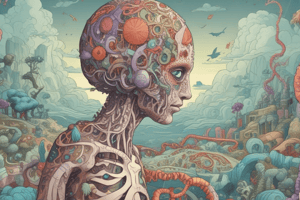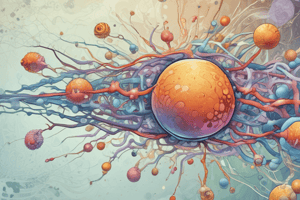Podcast
Questions and Answers
What is horizontal gene transfer?
What is horizontal gene transfer?
- The fusion of two different organisms' genetic materials.
- The vertical transfer of genetic material from parent to offspring.
- The duplication of genetic material within a single organism.
- The transfer of genetic material between organisms not through direct descent. (correct)
Which mechanism of horizontal gene transfer involves the uptake of free DNA from the environment?
Which mechanism of horizontal gene transfer involves the uptake of free DNA from the environment?
- Replication
- Transformation (correct)
- Transduction
- Conjugation
What is the significance of plasmids in microbial genetics?
What is the significance of plasmids in microbial genetics?
- They carry genes that can enhance the survival of microbes. (correct)
- They are essential for the synthesis of all cellular proteins.
- They are primarily responsible for horizontal gene transfer.
- They replicate only when the host reproduces.
How do mutations affect microorganisms?
How do mutations affect microorganisms?
What does comparative genomics help scientists understand?
What does comparative genomics help scientists understand?
What role do transcription factors play in gene expression?
What role do transcription factors play in gene expression?
Which of the following best describes operons in prokaryotes?
Which of the following best describes operons in prokaryotes?
What is a primary application of recombinant DNA technology?
What is a primary application of recombinant DNA technology?
How does the CRISPR-Cas system function as an adaptive immune system in microbes?
How does the CRISPR-Cas system function as an adaptive immune system in microbes?
Why is genomics important in the study of microbial ecology?
Why is genomics important in the study of microbial ecology?
Flashcards
Horizontal Gene Transfer (HGT)
Horizontal Gene Transfer (HGT)
The transfer of genetic material between organisms other than by descent from a common ancestor.
Transformation
Transformation
The uptake of free DNA from the environment by a bacterium.
Transduction
Transduction
The transfer of bacterial DNA by viruses called bacteriophages that infect bacteria.
Conjugation
Conjugation
Signup and view all the flashcards
Plasmids
Plasmids
Signup and view all the flashcards
Transcription Factor Binding Sites
Transcription Factor Binding Sites
Signup and view all the flashcards
Operons
Operons
Signup and view all the flashcards
CRISPR-Cas technology
CRISPR-Cas technology
Signup and view all the flashcards
Metagenomics
Metagenomics
Signup and view all the flashcards
Microbial Genomics
Microbial Genomics
Signup and view all the flashcards
Study Notes
Microbial Genetic Mechanisms
- Microbial genetics studies the genetic makeup and functions of microorganisms (bacteria, archaea, fungi).
- Microbes exhibit significant genetic diversity, adapting rapidly to various environments.
- The central dogma of molecular biology (DNA → RNA → Protein) applies to microbes.
- Horizontal gene transfer (HGT) is crucial for microbial adaptation and evolution.
Horizontal Gene Transfer (HGT)
- HGT is genetic material transfer between organisms, not by descent from a shared ancestor.
- Key HGT mechanisms include:
- Transformation: Taking up free DNA from the environment.
- Transduction: Bacteriophage (bacterial virus) DNA transfer.
- Conjugation: Direct cell-to-cell DNA transfer via pili.
- HGT facilitates the rapid spread of advantageous genes (e.g., antibiotic resistance), a significant healthcare concern.
- HGT drives microbial evolution and adaptation to new environments.
Microbial Genomes
- Microbial genomes vary greatly in size and complexity.
- Small genomes encode essential functions. Larger genomes contain specialized functions for complex lifestyles.
- Genome sequencing revolutionized microbial research, revealing evolutionary relationships and genetic diversity.
- Comparative genomics compares genomes to identify genes linked to traits (pathogenicity, metabolism).
Plasmids
- Plasmids are extrachromosomal, double-stranded DNA in bacteria and archaea.
- Plasmids replicate independently of the host chromosome.
- Plasmids often carry beneficial genes like antibiotic resistance, toxins, and metabolic abilities.
- Plasmids are crucial for HGT and microbial adaptation.
Mutation
- Spontaneous mutations occur naturally at low rates.
- Environmental factors (radiation, chemicals) increase mutation rates.
- Mutations affect microbial phenotypes, impacting fitness and survival.
- Mutations drive microbial evolution.
Regulation of Gene Expression
- Microbes regulate gene expression in response to environmental changes.
- Transcription factors bind to specific DNA, controlling downstream gene expression.
- Operons (clusters of genes transcribed together) are common in prokaryotes and regulate gene expression.
- Regulation is critical for efficient resource use and adaptation to varying conditions.
Genetic Engineering of Microbes
- Recombinant DNA technology allows modifying microbial genomes for useful applications.
- Gene knockouts, insertions, and modifications are common techniques.
- Applications include biotechnology (pharmaceuticals, biofuels), bioremediation (pollutant degradation), and basic research.
- Ethical and practical considerations surround this field.
CRISPR-Cas Systems
- CRISPR are microbial adaptive immune systems (Clustered Regularly Interspaced Short Palindromic Repeats).
- CRISPR-Cas systems allow microbes to remember past viral infections.
- Cas proteins target and degrade viral DNA.
- CRISPR-Cas technology is a powerful gene-editing tool.
Microbial Pathogenicity
- Understanding microbial genetics is essential to infectious disease study.
- Genes for virulence factors (toxins, adhesion molecules) enable infection.
- Pathogen genetic analysis aids in developing diagnostic tools and disease control strategies.
Genomics in Microbial Ecology
- Genomics is crucial for microbial ecology.
- Metagenomics studies microbial community genetic diversity (soil, water, gut).
- Microbial communities are dynamic; their genomes help us understand their roles and interactions with the environment.
Studying That Suits You
Use AI to generate personalized quizzes and flashcards to suit your learning preferences.
Description
This quiz covers the fundamental concepts of microbial genetics, focusing on the genetic mechanisms and diversity of microorganisms. It also delves into Horizontal Gene Transfer (HGT), its key mechanisms, and its impact on microbial evolution and adaptation. Test your understanding of how microbes share genetic material and the implications for antibiotic resistance.




